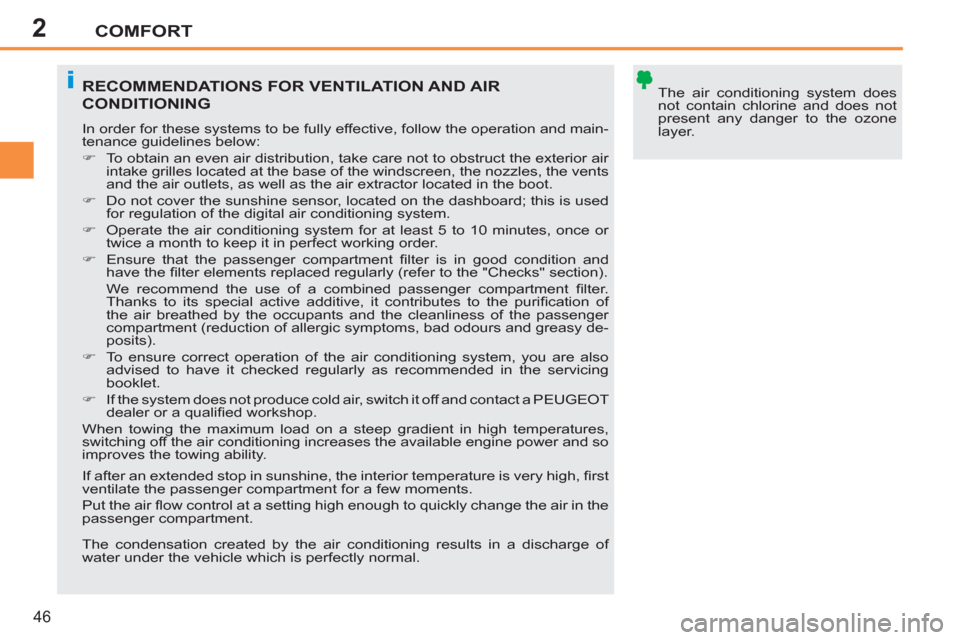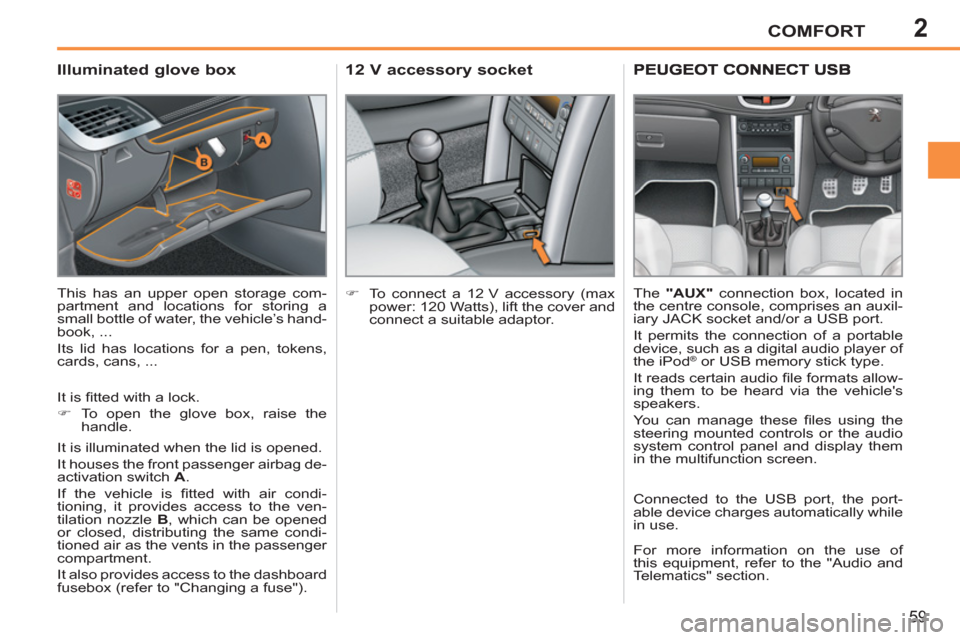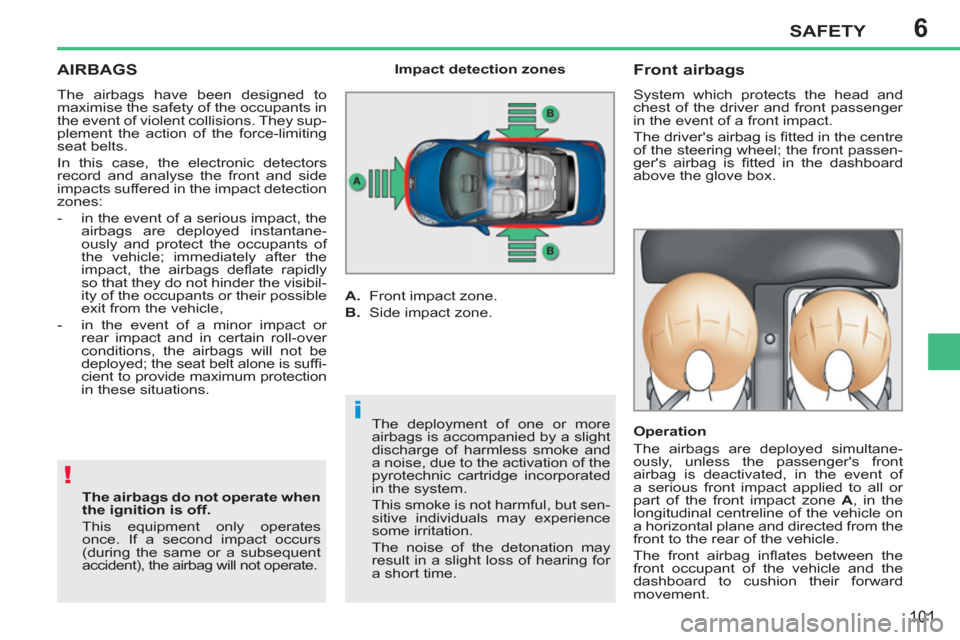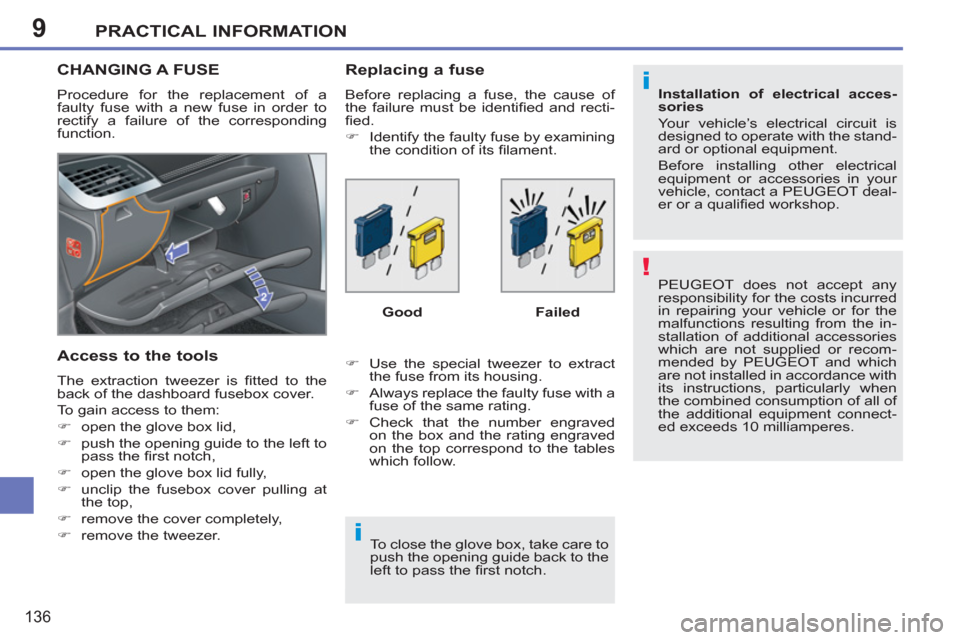2011.5 Peugeot 207 CC dashboard
[x] Cancel search: dashboardPage 25 of 224

1INSTRUMENTS and CONTROLS
23
Deactivation indicator lamps
If one of the following indicator lamps comes on, this confi rms that the corresponding system has been switched off intentionally.
This is may be accompanied by an audible signal and a message on the multifunction screen.
Warning lamp
is on
Cause
Action/Observations
Passenger's
airbag
system
fi xed. The control, located in the
glove box, is set to the OFF
position.
The passenger's front
airbag is deactivated.
In this case you can install
a "rear facing" child seat. Set the control to the ON
position to activate the
passenger's front airbag.
In this case, do not fi t a child seat in the rear-facing
position.
ESP/ASR
fi xed. The button, located
in the centre of
the dashboard,
is pressed. Its
indicator lamp is on.
The ESP/ASR is
deactivated.
ESP: electronic stability
programme.
ASR: anti-slip regulation. Press the button again to reactivate
the ESP/ASR manually. Its indicator lamp
goes off.
From approximately 30 mph (50 km/h),
the system is reactivated automatically.
The ESP/ASR system is reactivated
automatically when the vehicle is started.
Page 48 of 224

2
i
COMFORT
46
The air conditioning system does
not contain chlorine and does not
present any danger to the ozone
layer. RECOMMENDATIONS FOR VENTILATION AND AIR
CONDITIONING
In order for these systems to be fully effective, follow the operation and main-
tenance guidelines below:
�)
To obtain an even air distribution, take care not to obstruct the exterior air
intake grilles located at the base of the windscreen, the nozzles, the vents
and the air outlets, as well as the air extractor located in the boot.
�)
Do not cover the sunshine sensor, located on the dashboard; this is used
for regulation of the digital air conditioning system.
�)
Operate the air conditioning system for at least 5 to 10 minutes, once or
twice a month to keep it in perfect working order.
�)
Ensure that the passenger compartment fi lter is in good condition and
have the fi lter elements replaced regularly (refer to the "Checks" section).
We recommend the use of a combined passenger compartment fi lter.
Thanks to its special active additive, it contributes to the purifi cation of
the air breathed by the occupants and the cleanliness of the passenger
compartment (reduction of allergic symptoms, bad odours and greasy de-
posits).
�)
To ensure correct operation of the air conditioning system, you are also
advised to have it checked regularly as recommended in the servicing
booklet.
�)
If the system does not produce cold air, switch it off and contact a PEUGEOT
dealer or a qualifi ed workshop.
When towing the maximum load on a steep gradient in high temperatures,
switching off the air conditioning increases the available engine power and so
improves the towing ability.
If after an extended stop in sunshine, the interior temperature is very high, fi rst
ventilate the passenger compartment for a few moments.
Put the air fl ow control at a setting high enough to quickly change the air in the
passenger compartment.
The condensation created by the air conditioning results in a discharge of
water under the vehicle which is perfectly normal.
Page 61 of 224

2COMFORT
59
Illuminated glove box
This has an upper open storage com-
partment and locations for storing a
small bottle of water, the vehicle’s hand-
book, ...
Its lid has locations for a pen, tokens,
cards, cans, ...
12 V accessory socket
�)
To connect a 12 V accessory (max
power: 120 Watts), lift the cover and
connect a suitable adaptor.
The "AUX"
connection box, located in
the centre console, comprises an auxil-
iary JACK socket and/or a USB port.
It permits the connection of a portable
device, such as a digital audio player of
the iPod
® or USB memory stick type.
It reads certain audio fi le formats allow-
ing them to be heard via the vehicle's
speakers.
You can manage these fi les using the
steering mounted controls or the audio
system control panel and display them
in the multifunction screen.
Connected to the USB port, the port-
able device charges automatically while
in use.
For more information on the use of
this equipment, refer to the "Audio and
Telematics" section. It is fi tted with a lock.
�)
To open the glove box, raise the
handle.
It is illuminated when the lid is opened.
It houses the front passenger airbag de-
activation switch A
.
If the vehicle is fi tted with air condi-
tioning, it provides access to the ven-
tilation nozzle B
, which can be opened
or closed, distributing the same condi-
tioned air as the vents in the passenger
compartment.
It also provides access to the dashboard
fusebox (refer to "Changing a fuse").
Page 99 of 224

6
!
SAFETY
97
The ESP/ASR systems offer ex-
ceptional safety in normal driving,
but this should not encourage the
driver to take extra risks or drive at
high speed.
The correct functioning of these
systems depends on observation
of the manufacturer's recommen-
dations regarding the wheels (tyres
and rims), the braking components,
the electronic components and the
PEUGEOT assembly and opera-
tion procedures.
After an impact, have these sys-
tems checked by a PEUGEOT
dealer.
Deactivation
In exceptional conditions (starting a ve-
hicle which is bogged down, stuck in
snow, on soft ground, ...), it may be ad-
visable to deactivate the ASR and ESP
systems, so that the wheels can move
freely and regain grip.
�)
Press the "ESP OFF"
button, located
in the centre of the dashboard.
If this warning lamp comes on on the in-
strument panel and the indicator lamp on
the button comes on, this indicates that the
ASR and ESP systems are deactivated.
Reactivation
These systems are reactivated automat-
ically each time the ignition is switched
back on or from 30 mph (50 km/h).
�)
Press the "ESP OFF"
button again
to reactivate them manually.
Operating fault
If this warning lamp comes on,
accompanied by an audible sig-
nal and a message on the multi-
function screen, this indicates a
malfunction of these systems.
Have them checked by a PEUGEOT dealer.
TRAJECTORY CONTROL
SYSTEMS
Activation
These systems are activated automati-
cally each time the vehicle is started.
Anti-slip regulation (ASR) and
electronic stability programme
(ESP)
They come into operation in
the event of a grip or trajectory
problem.
This is indicated by fl ashing of
this warning lamp in the instru-
ment panel.
The anti-slip regulation (also known as
Traction Control) optimises traction to
prevent skidding of the wheels, by act-
ing on the brakes of the driving wheels
and on the engine.
The electronic stability programme acts
on the brake of one or more wheels and
on the engine to keep the vehicle on the
trajectory required by the driver, within
the limits of the laws of physics.
Page 103 of 224

6
!
i
SAFETY
101
AIRBAGS
The airbags have been designed to
maximise the safety of the occupants in
the event of violent collisions. They sup-
plement the action of the force-limiting
seat belts.
In this case, the electronic detectors
record and analyse the front and side
impacts suffered in the impact detection
zones:
- in the event of a serious impact, the
airbags are deployed instantane-
ously and protect the occupants of
the vehicle; immediately after the
impact, the airbags defl ate rapidly
so that they do not hinder the visibil-
ity of the occupants or their possible
exit from the vehicle,
- in the event of a minor impact or
rear impact and in certain roll-over
conditions, the airbags will not be
deployed; the seat belt alone is suffi -
cient to provide maximum protection
in these situations.
The airbags do not operate when
the ignition is off.
This equipment only operates
once. If a second impact occurs
(during the same or a subsequent
accident), the airbag will not operate.
Impact detection zones
A.
Front impact zone.
B.
Side impact zone.
Front airbags
System which protects the head and
chest of the driver and front passenger
in the event of a front impact.
The driver's airbag is fi tted in the centre
of the steering wheel; the front passen-
ger's airbag is fi tted in the dashboard
above the glove box.
Operation
The airbags are deployed simultane-
ously, unless the passenger's front
airbag is deactivated, in the event of
a serious front impact applied to all or
part of the front impact zone A
, in the
longitudinal centreline of the vehicle on
a horizontal plane and directed from the
front to the rear of the vehicle.
The front airbag infl ates between the
front occupant of the vehicle and the
dashboard to cushion their forward
movement. The deployment of one or more
airbags is accompanied by a slight
discharge of harmless smoke and
a noise, due to the activation of the
pyrotechnic cartridge incorporated
in the system.
This smoke is not harmful, but sen-
sitive individuals may experience
some irritation.
The noise of the detonation may
result in a slight loss of hearing for
a short time.
Page 106 of 224

6
!
SAFETY
104
For the airbags to be fully
effective, observe the following
safety rules:
Sit in a normal upright position.
Wear a correctly adjusted seat belt.
Do not leave anything between the
occupants and the airbags (a child,
pet, object...). This could hamper the
operation of the airbags or injure the
occupants.
After an accident or if the vehicle has
been stolen or broken into, have the
airbag systems checked.
All work on the airbag system must be
carried out by a PEUGEOT dealer or
a qualifi ed workshop.
Even if all of the precautions men-
tioned are observed, a risk of injury
or of slight burns to the head, chest
or arms when an airbag is triggered
cannot be ruled out. Indeed, the bag
infl ates almost instantly (within a few
milliseconds) then defl ates within the
same time discharging the hot gas via
openings provided for this purpose.
*
According to country.
Front airbags
Do not drive holding the steering wheel by its spokes or resting your hands on
the centre part of the wheel.
Passengers must not place their feet on the dashboard.
Smoke as little as possible as deployment of the airbags can cause burns or the
risk of injury from a cigarette or pipe.
Never remove or pierce the steering wheel or hit it violently.
Knee airbag *
Do not sit with your knees any nearer to the steering wheel than necessary.
Lateral airbags
Only use approved covers on the seats, compatible with the deployment of the
lateral airbags. For information on the range of seat covers suitable for your
vehicle, contact a PEUGEOT dealer (see the "Practical information - Accessories"
section)
Do not fi x or attach anything to the seat backs. This could cause injury to the
chest or arms when the lateral airbag infl ates.
Do not sit with the upper part of the body any nearer to the door than necessary.
Page 138 of 224

9
!
i
i
PRACTICAL INFORMATION
136
PEUGEOT does not accept any
responsibility for the costs incurred
in repairing your vehicle or for the
malfunctions resulting from the in-
stallation of additional accessories
which are not supplied or recom-
mended by PEUGEOT and which
are not installed in accordance with
its instructions, particularly when
the combined consumption of all of
the additional equipment connect-
ed exceeds 10 milliamperes.
Installation of electrical acces-
sories
Your vehicle’s electrical circuit is
designed to operate with the stand-
ard or optional equipment.
Before installing other electrical
equipment or accessories in your
vehicle, contact a PEUGEOT deal-
er or a qualifi ed workshop.
CHANGING A FUSE
Procedure for the replacement of a
faulty fuse with a new fuse in order to
rectify a failure of the corresponding
function.
Access to the tools
The extraction tweezer is fi tted to the
back of the dashboard fusebox cover.
To gain access to them:
�)
open the glove box lid,
�)
push the opening guide to the left to
pass the fi rst notch,
�)
open the glove box lid fully,
�)
unclip the fusebox cover pulling at
the top,
�)
remove the cover completely,
�)
remove the tweezer.
Replacing a fuse
Before replacing a fuse, the cause of
the failure must be identifi ed and recti-
fi ed.
�)
Identify the faulty fuse by examining
the condition of its fi lament.
�)
Use the special tweezer to extract
the fuse from its housing.
�)
Always replace the faulty fuse with a
fuse of the same rating.
�)
Check that the number engraved
on the box and the rating engraved
on the top correspond to the tables
which follow.
Good
Failed
To close the glove box, take care to
push the opening guide back to the
left to pass the fi rst notch.
Page 139 of 224

9PRACTICAL INFORMATION
137
Dashboard fuses
The fusebox is placed in the lower part
of the dashboard (left-hand side).
Access to the fuses
�)
refer to the "Access to the tools"
paragraph.
Fuse N°
Rating
Functions
G37
30 A
Retractable roof unit supply.
G38
20 A
Hi-Fi amplifi er.
G39
-
Not used.
G40
40 A
Trailer fuse box supply.
Fuse N°
Rating
Functions
F1
-
Not used.
F2
-
Not used.
F3
5 A
Airbags and pre-tensioners control unit.
F4
10 A
Clutch pedal switch, diagnostic socket,
electrochromatic interior mirror, air conditioning,
steering wheel angle sensor, particle emission fi lter
pump (Diesel).
F5
30 A
Rear electric windows, retractable roof.
F6
30 A
Front electric windows, folding mirrors supply.
F7
5 A
Front courtesy lamp, map reading lamps, sun visor
lighting, glove box lighting.
Fuse table